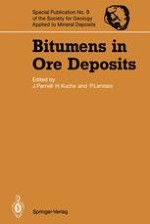1993 | OriginalPaper | Chapter
Organic Matter Associated with Mineralized Reduction Spots in Red Beds
Author : B. A. Hofmann
Published in: Bitumens in Ore Deposits
Publisher: Springer Berlin Heidelberg
Included in: Professional Book Archive
Activate our intelligent search to find suitable subject content or patents.
Select sections of text to find matching patents with Artificial Intelligence. powered by
Select sections of text to find additional relevant content using AI-assisted search. powered by
Reduction spots in marine and continental red beds were investigated for the presence of organic matter. The samples are from a wide variety of localities and from host rocks ranging in age from Precambrian to Cretaceous. It was found that organic carbon is present in a minor number of samples only, where it is a major component. Organic carbon in reduction spot cores is always associated with uranium minerals. Rock-Eval pyrolysis shows that this organic matter is depleted in H and enriched in O relative to possible precursor materials. Pyrolysis-GC-MS indicates that this insoluble, high-molecular weight organic material primarily consists of aromatic structures, similar to other occurrences of organic matter associated with uranium mineralization. The stable isotopic composition of the organic matter is highly variable (−23.1 to −49.8% relative to PDB) but consistent with a derivation from oil, gas, or bacterial biomass. In reduction spots devoid of organic carbon, stable isotopes (C, O) of carbonates are not significantly different in cores and in host rocks and therefore do not provide evidence for the former presence of organic carbon. Several possibilities for the origin of organic carbon in reduction spots are discussed but no conclusive evidence can be presented yet. Mineralogically, reduction spots with organic matter are generally similar to those without. A significant difference is the abundance of roscoelite in organic-poor reduction spots, while this mineral is absent in organic-rich ones.
